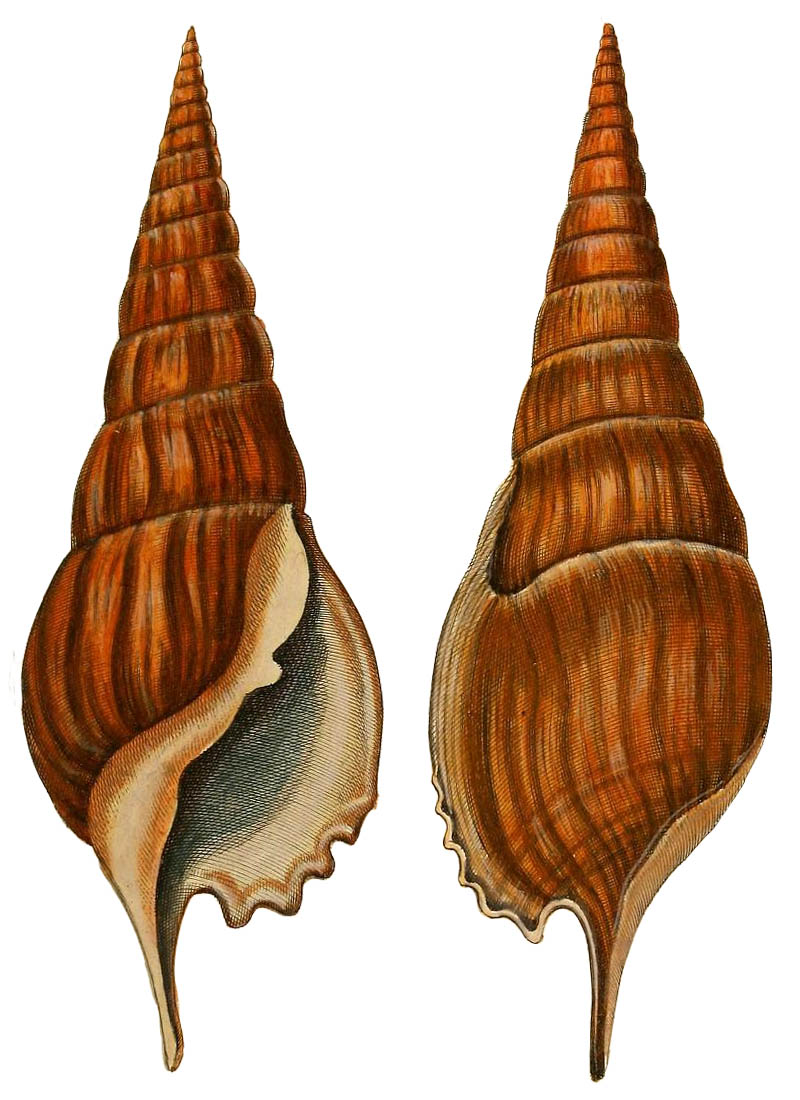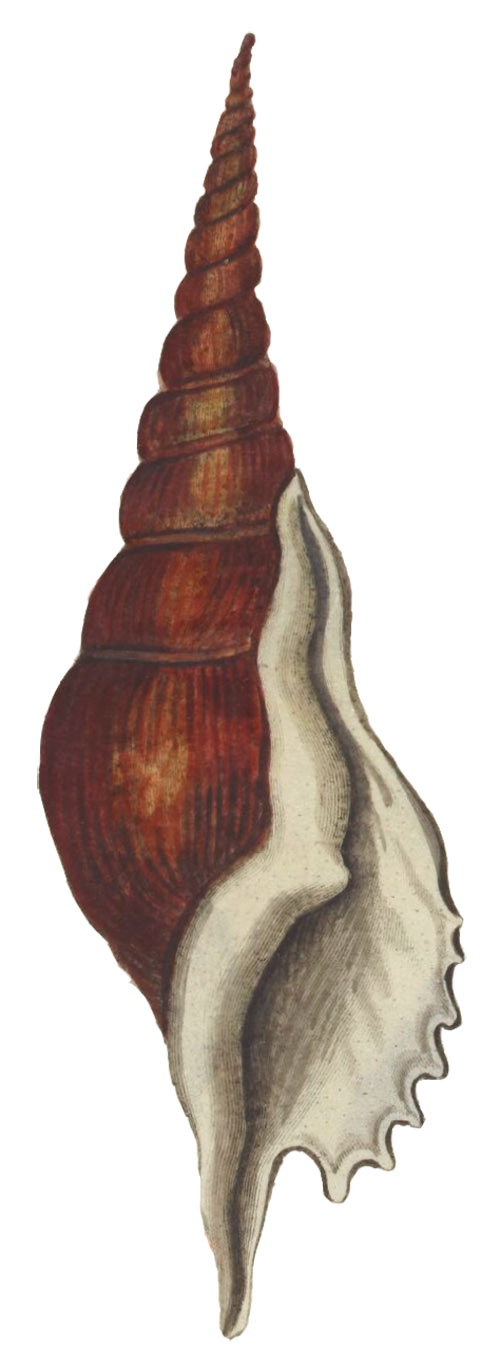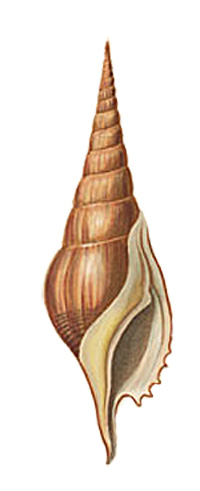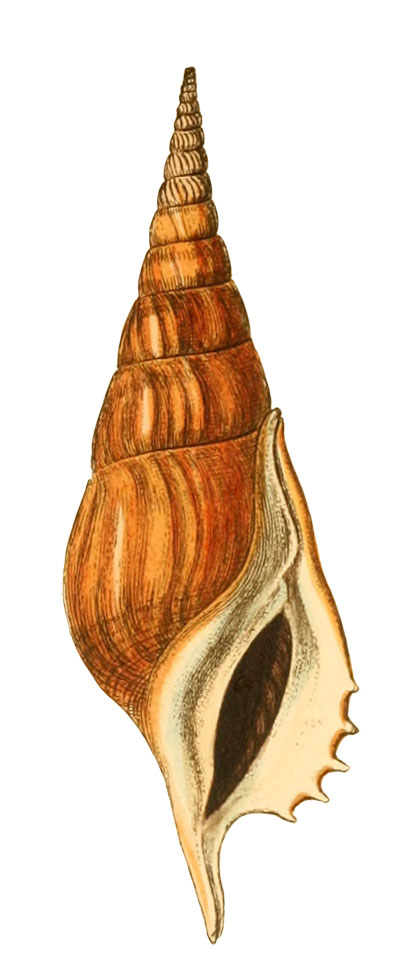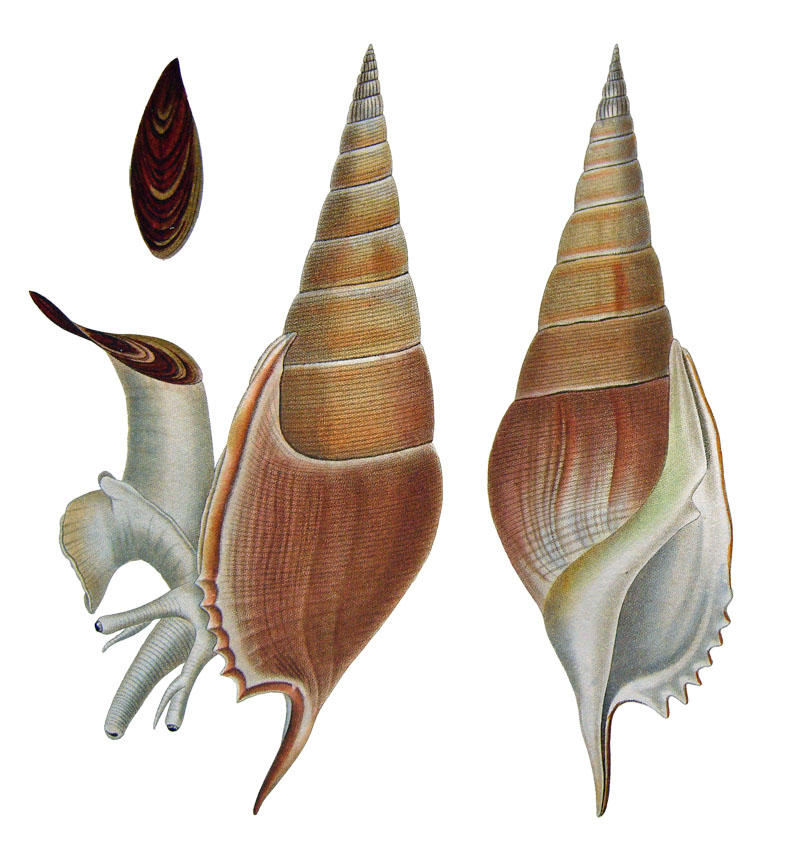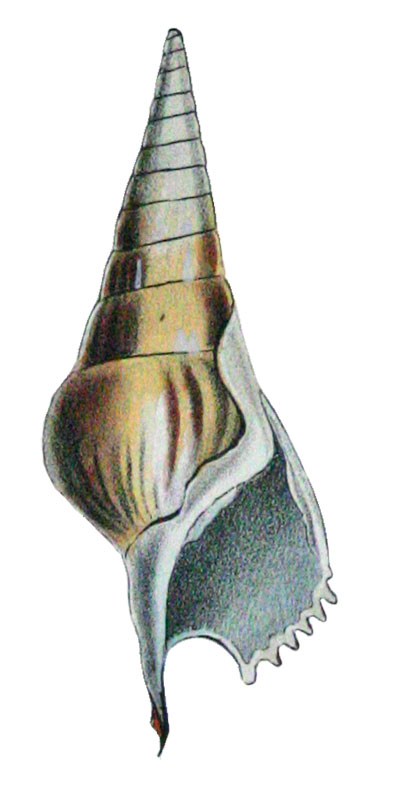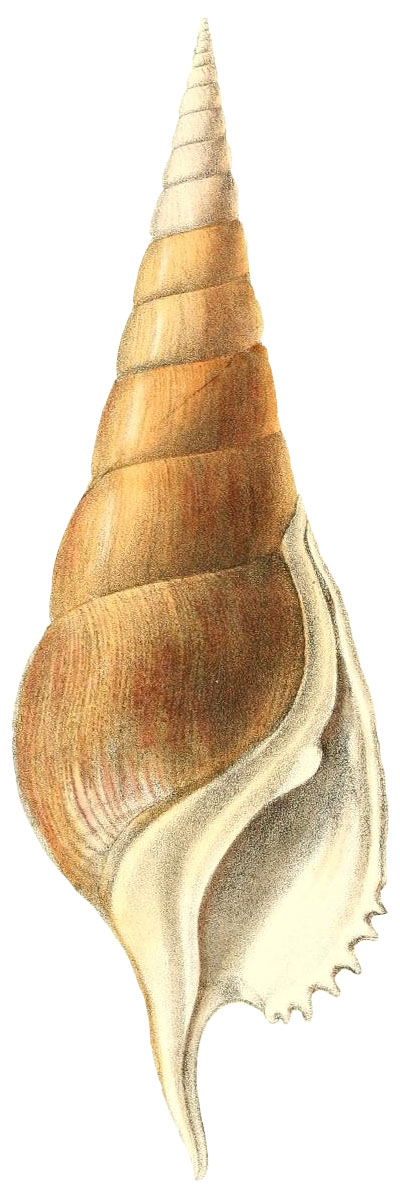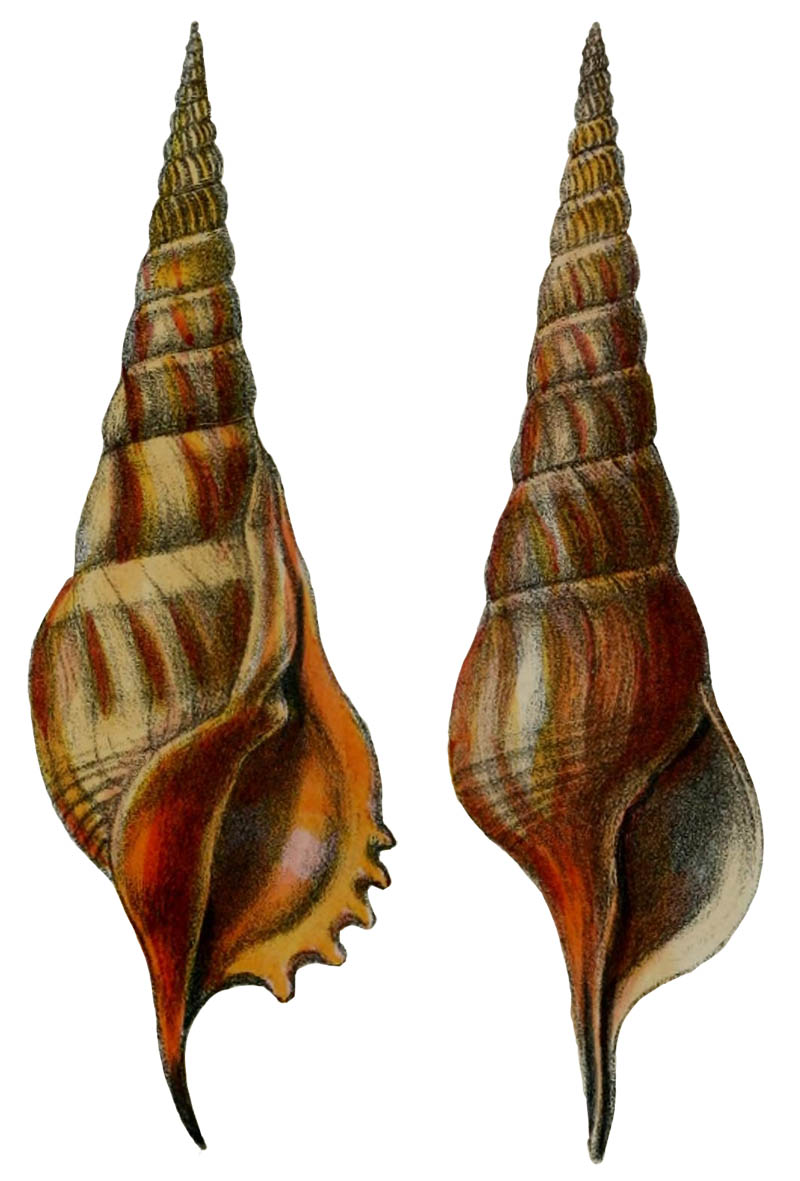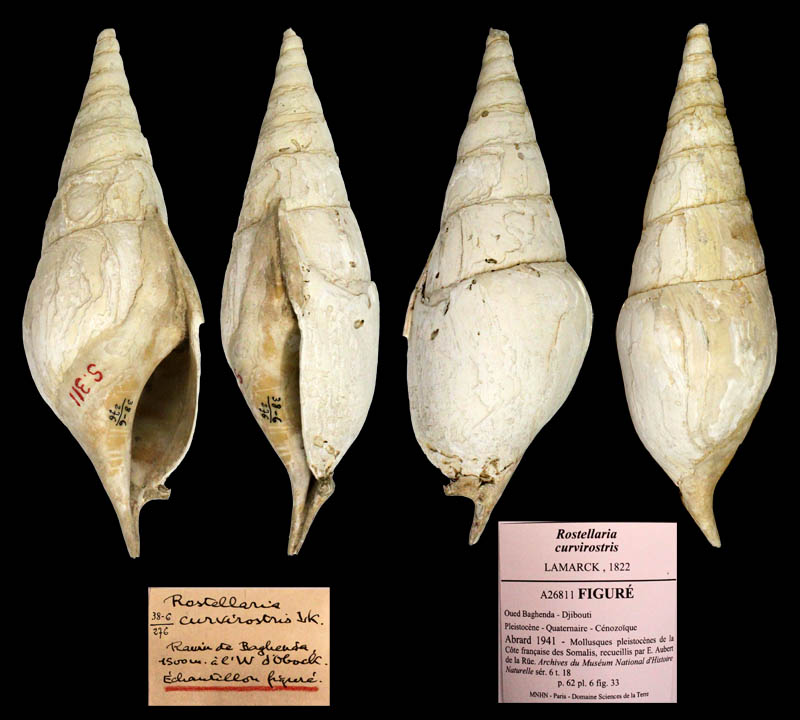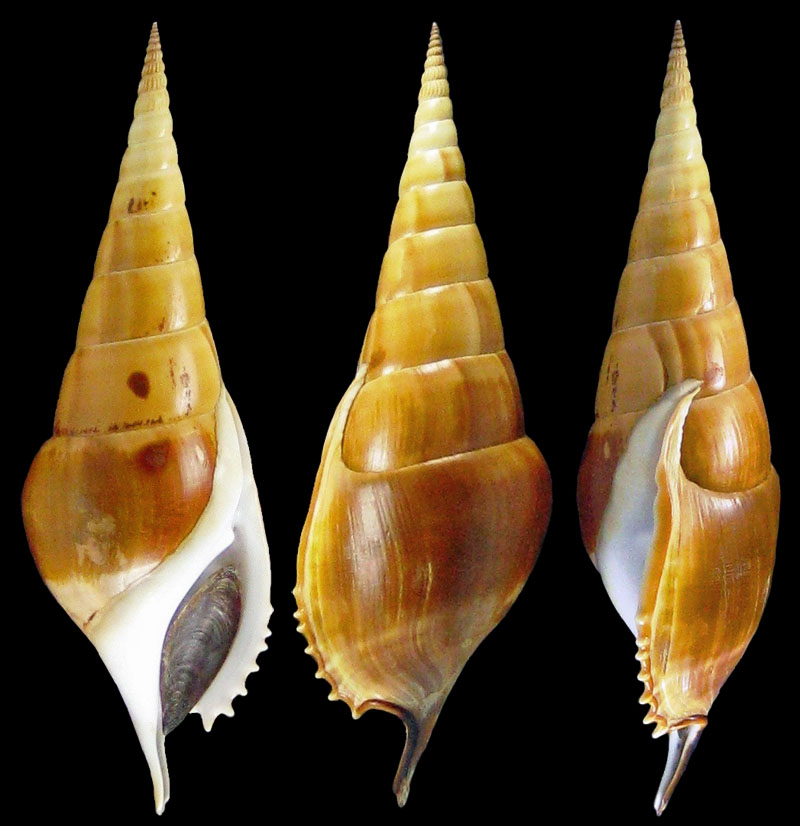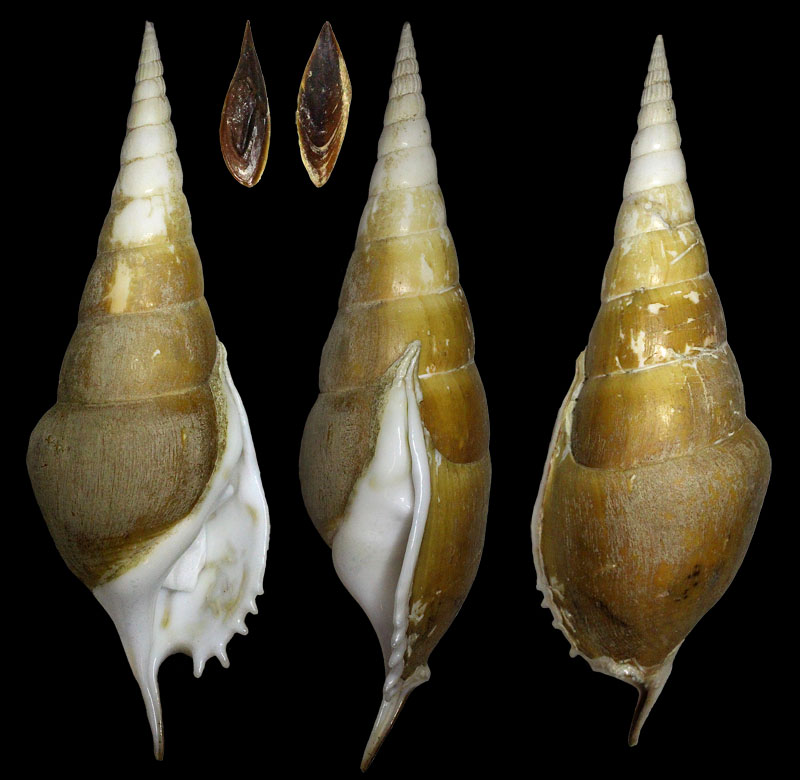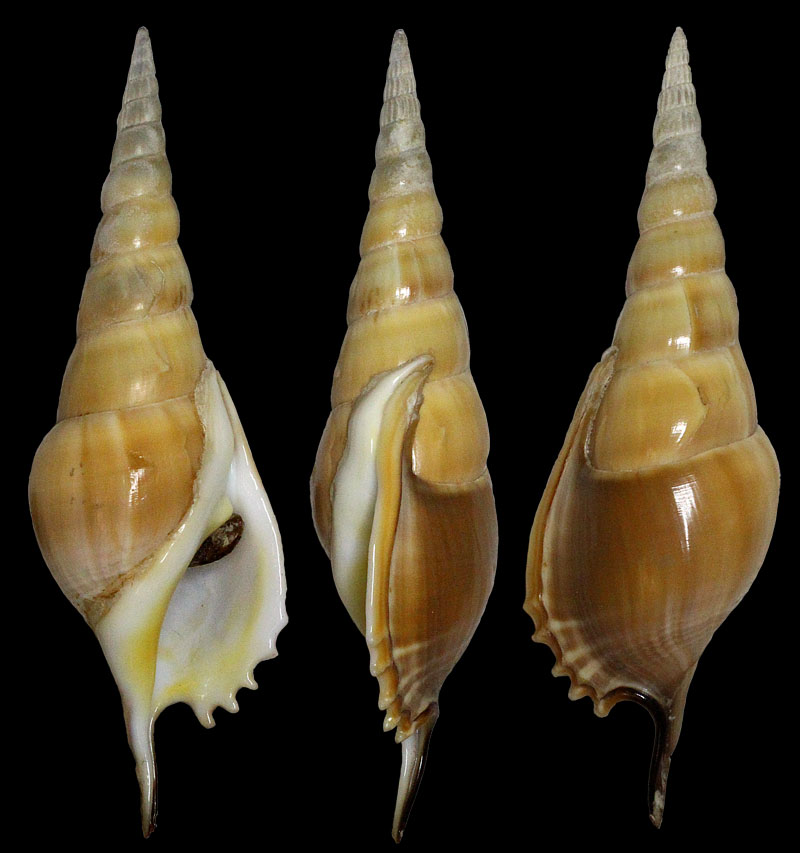|
edit SideBar
|
Species / Tibia Insulaechorab
Stromboidea
Original Description of Tibia Insulae Choräb by Roeding, 1798, p. 123:
- "1 T. Insulae Choräb. Die grosse dicke Stern-Nadel."
Röding, 1798, p. 123 cited:
- Gmel. Strombus fusus. sp. 1.
- Martini 4. t. 158. f.1495. 96.
"Sternspindel" in Martini & Chemnitz, 1780, pl. 158, fig. 1495, 1496
Kronenberg & Burger, 2002, p. 46:
- "We here designate the specimen in Chemnitz (1780: fig. 1495) as the lectotype of Tibia insulaechorab Röding, 1798. The present whereabouts of this specimen are unknown to us, but it may be in the Zoological Museum, University of Copenhagen (Denmark) or at the Zoological Institute, St.-Petersburg, Russia (Martynov, 2002)."
History and Synonymy
Tibia insulaechorab Röding, 1798: 123
- Syn.: Rostellaria brevirostris Schumacher, 1817: 223
- ?Syn.: Rostellaria cornuta "Martin" Pfaff & Friedländer, 1803: 90
- Syn.: Rostellaria curvirostra Lamarck, 1816: 4, pl. 411, figs 1a, 1b
- Syn.: Rostellaria curvirostris Lamarck, 1822: 192
- Syn.: Rostellaria curvirostrum Sowerby 2nd, 1842: 22
- Syn.: Rostellaria dentula Perry, 1811: Pl. 10, fig. 3
- Syn.: Gladius fusus Lin. Jousseaume, 1888: 175 [allocated to Muricidae, non Strombus fusus Linnaeus, 1758]
- Syn.: Tibia insulaechorab var. alba Romagna Manoja, 1977: 10 [unavailable; published as a varietal name after 1960 ICZN art. 15.2]
- Syn.: Tibia insulaechorab scalariformis Romagna Manoja, 1977: 10, 13 top fig. on left [unavailable]
- Syn.: Tibia luteostoma Angas, 1878: 313, pl. 18, figs 8 (juv.) 9 (adult)
- Syn.: Rostellaria magna Mörch, 1852: 63
- Syn.: Fusus magnus Schröter, 1788: 38 [nomen oblitum]
- Syn.: Rostellum ternatanum Montfort, 1810: 519, fig. on p. 518
1788
Fusus magnus Schröter, 1788: 38 [nomen oblitum]
- Schroeter, 1788, p.38 points to Martini & Chemnitz, Vol. IV, 174.178.244.331.339
1791
Gmelin, 1791, p. 3506 on Strombus fusus:
- "Str. testa turrita laevi: cauda subulata, labro dentato."
Gmelin cited references for three forms:
- "Mus. Lud. Ulr. 638. n. 316. Murex fusus.; List. Conch. t. 854. f. 12.; Seb. mus. 3. t.56. f. 1.; Knorr Vergn. 5. t.6. f.I. et t.7. f.1; Martin. Conch. 4. t.158. f. 1495, 1496.; Spengl. selt. Conch. t.3. f.B.; Chemn. Naturf. 9. t.6. f.2.; Schroet. Journ. 5. t.I. f.2."
- "Seb. mus. 3. t.56. f.3.; Martin. Conch. 4. t.158. f.1497."
- "List. Conch. t.854. f.II. et t.916. f.9.; Bonann. recr. et mus. Kircher. 3. f.121.; Argenv. Conch. t.10. f.D; Klein ostr. t.4. f.77.; Seb. mus. 3. T. 56. f.2.; Martin. Conch. 4. t.159. f.1500.; Chemn. Conch. 4. p.344. vign.41."
- "Habitat frequens in mari rubro, 3) rarissimus, testa fusca, laevi, ad basin transversim striata, columella alba, cauda extrinsecus nigra. dubii generis, labro dentato cum strombis conveniens, cauda magis recta recedens, a muricibus testa laevi."
- Comment: This is cited by Roeding, 1798
1793
Fuseau á dents Buchoz, 1793. pl. 8, fig. 8
1803
C.H. Pfaff & M. Friedländer, 1803, p. 90:
- "XXI. Geschlecht. Rostellaria. Testa univalvis, fusiformis vel subturrita; basi desinens in canalem porrectum, rostro acuto similem. Labrum integrum vel dentatum, aetate subdilatatum; lacuna canali contigua. - Dieses Geschlecht ist selten. Rostellaria cornuta Martin Conch. Vol. IV. t.158. ist die merkwürdigste Species des Geschlechts."
- Comment: It is not clear from Pfaff & Friedländer to which of the two species Martini presented on pl. 158 they point. So this might either be a synonym of Tibia insulaechorab or a recent Varicospira sp.
1811
Rostellaria dentula Perry, 1811, pl. 10, fig. 3
1816
Rostellaria curvirostra Lamarck, 1816: 4, pl. 411, figs 1a, 1b
1817
Original Description of Rostellaria brevirostra by Schumacher, 1817:
- p.222: "Columella subflexuosa. [beta] falce suprascandente, rostro breve."
- p. 223: "Rostellaire à bec court. Rostellaria brevirostra.
- Chemn. 4. pag. 331. Tab. 158. fig. 1495-1497.
- Il ne faut qu'un coup d'oeil, pour qu'un novice même ne confonde pas cette coquille avec la précedente; cependant ces deux coquilles, dont les marques sont si distinctes, ont été encore confondues par Mr. Bosc Tom. 4. pag. 243. comme il les prend toutes deux pour le Rostellaria subulata. On n'a qu'à regarder les figures des deux coquilles avec un peu d'attention, pour s'appercevoir tout aussitôt qu'elles sont de diverses espèces; et les caractères en sont si différents et si marqués, qu'il y a peut-être des conchyliologistes, qui les prendrent plutôt pour deux genres différents, que seulement pour deux espèces. La figure de Chemn. 4. Tab. 158. fig. 1497 a sans doute échappé à l'impimeur étant citée pour le Strombus clavus dans l'ouvrage de Mr. Bosc, comme cette coquille y a le même droit que les figures des coquilles ci-dessus nommées. Il n'y a pas de doute, comme je viens dire, que la figure de Chemnitz 1497 n'en soit une jeune ou encore imparfaite de la Rostellaria brevirostra; comme ces figures, savoir 1501 et 1502 en sont de jeunes et imparfaites de l'espèce précédente; ce ne sont pas la des conjectures: mais je puis justifier mon opinion, non seulement par mes recherches, mais encore plus par l'autorité de Mr. Hvas. On me pardonnera la subdivision que j'ai faite de ce genre, comme on n'en connoit qu'un très petit nombre d'espèces; mais elle m'a paru nécessaire, comme les deux espèces ci-dessus nommées, ont été auparavant confondues, et qu'elles ont les caractères requis pour ces deux subdivisions."
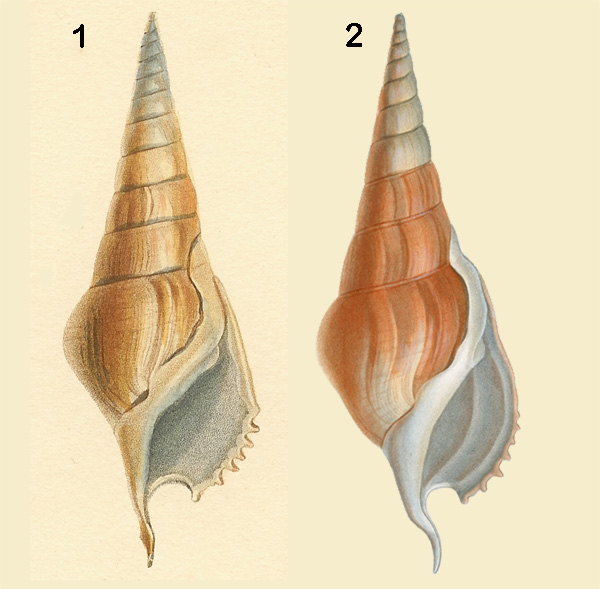 - Rostellaire bec arqué (Rostellaria curvirostris, Lamk.) by Cuvier, 1817 pl. 61bis, 2
- Rostellaire bec arqué (Rostellaria curvirostris, Lamk.) by d'Orbigny, 1841 pl. 22, 3
1829
Rostellaria curvirostris in Swainson, 1829, pl. 1(34), fig. 1
- "Rostellaria curvirostris. Short-beaked Spindle."
- "Div. 2. Sinus simple; formed by the prolongation of the canal."
- "Rostellaria. Lam. Outer lip dentated, but not dilated. Basal canal long."
- "Specific Character. Basal canal short: spiral canal thickened, and perpendicularly ascending on the spire. Strombus fusus. Linn. Gm. 3506. Lister, 854, 12. Seba, 3, 56, 1. Rostellaria curvirostris. Lam. Sys. 7, 1, 192. Ency. Meth. pl. 411, f. 1."
- "This elegantly formed shell is a native of the Red and Indian Seas. It is the most common of the few species retained in the genus Rostellaria; all these are recent; while Hippochrenes has occured only in a fossil state."
1842
Description of Rostellaria curvirostrum by Sowerby II, 1842, p. 22:
- "T. crassa, laevi, fusiformi; apice plicato; anfractibus numerosis, convexiusculis; canali postico, super anfractus penultimae partem, decumbenti; canali antico brevi undato."
- "This is the well known species with a short curved beak; the general colour is reddish brown, with the aperture white."
Localities: Moluccas and red Sea
Rostellaria curvirostrum in Sowerby, 1842, pl. V, fig. 9 (Thesaurus Conchyliorum, or Monographs of Genera of Shells, Vol. 1)
1843
Rostellaria curvirostris in Kiener, 1843, Vol. 4, Rostellaria pl. 1, fig. 1
Rostellaria curvirostris juvenile in Kiener, 1843, Vol. 4, Rostellaria pl. 3, fig. 1
- Kiener gives a detailed description and mentioned the length (200 mm) and where it lives ("Habite l'océan de Moluques et la mer Rouge"). It is different from Sowerbys Rostellaria curta.
1847
Rostellaria curvirostris in Berge, 1847, pl. 37, fig. 7
1851
Rostellaria curvirostris in Reeve, 1851, Rostellaria, pl. 1, fig. 2
1878
Original Description of Rostellaria luteostoma by Angas, 1878, p. 313:
- "Shell fusiform, solid, light brown, paler below the sutures; spire attenuated, apex sharp-pointed; whorls 15, the first 9 or 10 longitudinally strongly plicate, those nearest the apex being cancellated with fine transverse ridges, the lower whorls nearly smooth, with a few concentric grooves near the base or the last whorl; columella covered with a strong tumid polished callus; outer lip with 5 digitations on the lower half of the margin; posterior canal extending upwards beyond the centre of the third whorl; beak moderate, nearly straight in the young shell, somewhat curved outwards in the adult; aperture golden yellow, deepest on the lower portion of the columella. Length 4 inches 3 lines, diam. 1 inch 3 lines."
- Locus typicus: "Kurrachi, near the mouth of the Indus" (Karachi, Pakistan)
Comment Angas, 1878, p. 313:
- "This beautiful shell forms an interesting addition to the restricted genus Rostellaria (Gladius of Klein), of which hitherto only about half a dozen recent species have been described. All the known species inhabit the Asiatic seas, none having been met with in any part of the New World. The two examples (one young and the other in the adult state) from which I have taken my description, are from the collection of Sir David Barclay, and are, so far as I am aware, unique in this country."
Rostellaria luteostoma Angas, 1878, pl. XVIII, fig. 8, 9
1904
Sturany, 1904, p. 254:
- "148. Rostellaria curvirostris Lm. Von den Localitäten 21, 31, 35, 37, 41, 43, 45, 46."
- p. 237:
- "21. Koseir, 16. Januar und 25. Februar 1898 (Nördlichster Theil des großen Rothen-Meer-Beckens 28.°-26.° NBr).
- 31. Jidda (Djeddah), 3-8. November, 10. und 16. December 1895, 1. Februar 1898 (22.°-20.° NBr)
- 35. Kunfidah (Kunfuda), 16-17. Januar 1898 (20.°-18.° NBr.)
- 37. Ras Turfa, 11. Januar 1898 (18.°-16.° NBr.)
- 41. Massawa (Massaua), 16. November 1897 und 28-31. December 1897 (16.°-14.° NBr.)
- 43. Kamaran-Insel, 1-3. November 1897 (16.°-14.° NBr.)
- 45. Ghuleifaka (= Landzunge Ras Mujamela), 20-21. December 1897 (16.°-14.° NBr.)
- 46. Hanfela-Insel, 23. November 1897 (16.°-14.° NBr.)"
- see also Stagl et al., 1996
1906
Smith, 1906, p. 725:
- "350 shells from Japan, China, etc., mostly belonging to species recently described and new to the collection, and including the types of Rostellaria luteostoma, ... Purchased."
1941
Rostellaria curvirostris Lamarck, 1822; figured in Abrard, 1941; Pleistocene; Oued Baghenda, Djibouti, Gulf of Aden, Arabian Sea; 205 mm; Coll. MNHN no. A26811, Copyright Museum national d'Histoire naturelle Paris
2013
Liverani, 2013, p. 11:
- "Range: Red Sea; out of the Red Sea along the coast of Yemen to Aden but not further; along the African coast to North Somalia."
Specimens from private collections
Tibia insulaechorab Röding, 1798; Djibouti, Gulf of Aden, Arabian Sea; 200 mm; Coll. Paul Merrill
Tibia insulaechorab Röding, 1798; Harmil, Dahlak, Erithrea; Coll. Koenraad De Turck
Tibia insulaechorab forma luteostoma Angas, 1878; Dalilak, Ethopia; 160 mm; Coll. Koenraad De Turck
References
- Abrard (R.), 1941. Mollusques pleistocènes de la Côte française des Somalis, recueillis par E. Aubert de la Rüe. Archives du Muséum National d'Histoire Naturelle, sér. 6, t. 18, p. 5-105
- Angas, G.F., 1878. Descriptions of nine new species of land and marine shells from various localities. Proceedings of the scientific meetings of the Zoological Society of London for the year 1878: 311 – 314, pl. 18, Fulltext
- Buchoz, 1793. Premiere Centurie de planches enluminées et non enluminées, Representant au Naturel, Ce qui se trouve de plus Interessant et de plus Curieux parmi les animaux, les vegetales et les mineraux; Lacombe Libraire, Paris; URL: https://gallica.bnf.fr/ark:/12148/bpt6k10665984/f7.item
- Kronenberg & Burger, 2002
- C.H. Pfaff & M. Friedländer, 1803. Über die Fossilien der Gegenden von Paris, von Lamarck (Fortsetzung) in Die neuesten Entdeckungen französischer Gelehrten in den Gemeinnützigen Wissenschaften und Künsten; IV. Annales du Museum d'histoire naturelle. Französische Annalen für die allgemeine Naturgeschichte, Physik, Chemie, Physiologie und ihreGemeinnützigen Anwendungen Band 3, IX. Heft, p. 84-99.
- Roeding, 1798
- Schröter, J.S., 1788. Vollständiges alphabetisches Namen Register über alle zehn Bände des, von dem seel. herrn D. Martini in Berlin angefangen, und vom herrn Pastor Chemnitz in Kopenhagen fortgesezten und follendeten systematischen Conchylien Cabinets. 1–124. Raspischen Buchhandlung, Nürnberg (Fulltext)
- Schumacher, C. F. 1817. Essai d'un nouveau système des habitations des vers testacés. Avec XXII planches. - pp. [1-3], 1-287, Pl. I-XXII [= 1-22]. Copenhague. (Schultz). (Fulltext)
- E.A. Smith, 1906. 9. Mollusca in The History of the Collections contained in the Natural History Departments of the British Museum; vol. 2; British Museum (Natural History), London, pp. 701-730, Fulltext
- Sowerby, 1842
- Sturany, R., 1904: Expeditionen S.M. Schiff "Pola" in das Rote Meer. Nördliche und südliche Hälfte. 1895/96-1897/98. Zoologische Ergebnisse. XXIII. Gastropoden des Rothen Meeres. - Denkschr. Kaiserl. Akad. Wiss. Wien, math.-nat. Kl. (Ber. Comm. oceanogr. Forsch.) 74: 209-283, Fulltext
- V. STAGL, H. SATTMANN & P.C. DWORSCHAK, 1996. The material of the Pola Red Sea expeditions (1895-1898) in the collections of the Natural History Museum in Vienna; in Uiblein, F., Ott, J., Stachowitsch, M. (Eds), 1996: Deep-sea and extreme shallow-water habitats: affinities and adaptations. Biosystematics and Ecology Series 11: 29-41, Fulltext
- Swainson, W. 1820-1833. Zoological Illustrations, or original figures and descriptions of New, Rare, or Interesting Animals, selected chiefly from the classes of Ornithology, Entomology, and Conchology, and arranged according to their natural affinities. London; Baldwin, Cradock, and Joy, 6 vols. [series 1: 1-3; series 2: vol.1, 1829, vol. 2, 1831-32, vol. 3, 1832-33], Fulltext
|

